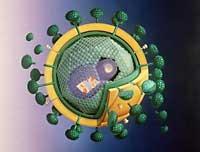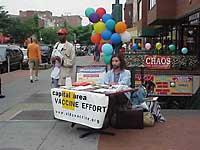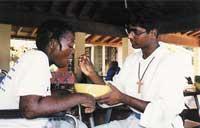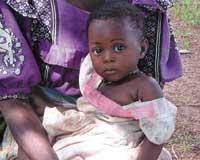First AIDS vaccine: poor results
2003/02/25 Carton Virto, Eider - Elhuyar Zientzia

The Aidsvax vaccine reaches the third phase of clinical sessions. And that's a lot, according to Zulaika. Keep in mind that this phase is the last one that is done before the marketing of the drug and that it is done on a large scale. Volunteers who participate in this phase should represent as best as possible the population to which they will be subjected and therefore people of all kinds participate.
In this case, 5,417 volunteers, 5,108 men and 309 women participated. These volunteers have spent three years in the United States, Canada, Puerto Rico and the Netherlands. Two thirds have received the vaccine and the other third placebo and have been advised to all to avoid dangerous sexual intercourse. It should be noted that the percentage of contamination of both groups is similar.
Aidsvax vaccine base
The Aidsvax vaccine is based on a genetically modified protein. This protein mimics a type B HIV virus protein in the skin and its goal is for the immune system to generate antibodies against this protein. The vaccine had no capacity to make volunteers sick, but was expected to protect them from the real HIV virus. The type of HIV virus investigated is the most common in North America, Europe, Australia, Japan and Puerto Rico. In fact, the AIDS virus has a great capacity for change and that is why it is so difficult to develop an effective and global vaccine against it.

This same laboratory is conducting a new important clinical session in Thailand with 16,000 volunteers. In this case, the program collects people at risk of AIDS infection by drug injection and seeks a vaccine against the type B and E virus. These guys dominate South and East Asia. In sub-Saharan Africa, classes C and D are the most common.
Precisely, the VaxG laboratory wanted to emphasize that among Black and Asian people who participated in their session the results have been much better, but the variability of the HIV virus makes Africans have no hope options.
Few Blacks and Asians
Of the 5,417 volunteers who participated in the clinical session, very few were Black or Asian, 314 and 73 respectively. VaxGen has defended 67% of voluntary non-white vaccines, but the sample is too small to extrapolate the results to the entire population. The company considers that the probability of these results being due to chance is less than 2%, but it is not the same for many who have criticized the investigation.
The U.S. Institute of Allergy and Infectious Diseases abandoned its research in 1994 because the preliminary results announced its uselessness. His boss has sharply criticized VaxGen's behavior: "They have not proven effective." The results of the subgroups, for their part, have seemed very interesting and provocative, "if it is true".

According to Cornell University expert John Moore, the sample is too small to get any conclusions. In addition, this researcher has rejected the alleged reasons for explaining the good results observed in Black volunteers.
After knowing the bad results of the vaccine, the quote of the company Vaxagen has dropped 57% in stock, so it is not surprising that it intends to squeeze the few good results they have obtained. The company has announced more attempts with blacks and Asians to find out if the Aidsvax vaccine can be really useful for these groups. You will see if they will meet this prediction or if it has been a strategy to save the current situation of the company. Any AIDS vaccine should have a wider scope.
More information on AIDS in the Zientzia.net dossiers.

Gai honi buruzko eduki gehiago
Elhuyarrek garatutako teknologia





